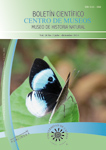Authors
Abstract
Camera trapping has been used in studies of animal ecology, behavior and conservation as a tool to gain valuable information about biodiversity and behavior of wild organisms. In order to examine the relative abundance and activity patterns of walking birds and associated mammals, 15 camera traps were installed in the foothills of the PNN Farallones de Cali between January and November 2013. This area, which is between 1,100 and 1,300 masl, is highly threatened by deforestation and the urban expansion of Cali. Twenty species, representing 83% of the fauna expected for the area were recorded according to the Jack -1 estimator. The dominant species were the Central American agouti (Dasyprocta punctata), the grey-necked wood rail chilacoa (Aramides cajanea) and the black ear edopossum (Didelphis marsupialis). The domestic dog, with 129 photos was the fourth most abundant. Most walking birds used more the forest habitat than the scrub habitat, with the notable exception of the little tinamou. However, both habitats are complementary and important for conservation. This study increases the distribution range in altitude for Odontophorus hyperythrus. It was also found that walking birds are mainly diurnal and some domestic and wild mammals overlap this activity, being potential predators or competitors. This study provides direct evidence of the high value of natural habitats, forests and scrubs for the conservation of wildlife in a tropical area of high biological value and which is sensitive to human disturbance at the immediate time scale.
Keywords:
References
BOSUALDO, C.V., 2011. Choosing the best non-parametric richness estimator for benthic macroinvertebrates databases. Rev. Soc. Entomol. Argent., 70(1-2): 27-38.
BRENNAN, P.L.R., 2004. Techniques for studying the behavioral ecology of forest-dwelling tinamous (Tinamidae). Ornitologia Neotropical, 15: 329-337.
BRENNAN, P.L.R., 2010. Clutch predation in great tinamous Tinamus major and implications for the evolution of egg color. J. Avian Biol., 41: 1- 8.
BRENNAN, P.L.R., 2012. Mixed paternity despite high male parental care in great tinamous and other Palaeognathae.Anim. Behav.,84: 693-699.
BIRDLIFE INTERNATIONAL, 2013. Odontophorus hyperythrus (en) IUCN. IUCN Red List of Threatened Species.Recuperado de www.iucnredlist.org.
COLWELL, R.K., 2013. Estimate S. Statistical estimation of species richness and shared species from samples. Recuperado de http://viceroy.eeb.uconn.edu/estimates/.
CAMPOS, C.B., ESTEVES, C.F., FERRAZ, K.M., CRAWSHAW,P.G. & VERDADE, L.M., 2007. Diet of free-ranging cats and dogs in a suburban and rural environment, south-eastern. Brazil J. Zool.,273: 14-20.
ETTER, A.& WYNGAARDEN, W.V., 2000. Patterns of landscape transformation in Colombia, with emphasis in the Andean región. Ambio, 29: 432-439.
FRANCO, P., FIERRO-CALDERON, K., KATTÁN, G., 2006. Population densities and home range sizes of the Chestnut Wood-quail.J. Field Ornithol., 77 (1): 85-90.
HILTY, S.L. & BROWN, W.L., 2009. Guía de las Aves de Colombia. Asociación Colombiana de Ornitología, Bogotá, Colombia.
KATTÁN, G.H., 2003. Fragmentación: patrones y mecanismos de extinción de especies: 561-590 (en) GUARIGUATA, M.R. & KATTÁN, G.H. (eds.).Ecología y conservación de Bosques Neotropicales. Libro Universitario Regional (EULAC-GTZ), Cartago, Costa Rica.
LAMBERT, T.D., KAYS, R.W., JANSEN, P.A., ALIAGA-ROSSEL, E. & WIKELSKI, M., 2009. Nocturnal activity by the primarily diurnal Central American agouti (Dasyprocta punctata) in relation to environmental conditions, resource abundance and predation risk. J. Trop. Ecol.,25: 211-215.
DAVIES, S.J.F., 2003. Rattles and Tinamous: Tinamidae, Rheidae, Dromaiidae, Casuariidae, Apterygidae, Struthionidae. The Wilson Bulletin, 115 (2): 217-218.
DÍAZ-PULIDO, A. & PAYÁN GARRIDO, E., 2012. Manual de Fototrampeo: una herramienta de investigación para la conservación de la biodiversidad en Colombia. Instituto de Investigaciones de Recursos Biológicos Alexander von Humboldt y Panthera Colombia.
IUCN, 2013. IUCN Red List of Threatened Species. Version 2013. 2. Recuperado dewww.iucnredlist.org.
LENTH, B.E., KNIGHT, R.L., BRENNAN, M.E., 2008. The Effects of Dogs on Wildlife Communities. Nat. Area. J., 28: 218-227.
MAFFEI, L., CUELLAR, E. & JONES, A. J.,2002. Uso de trampas-Cámara para la evaluación de mamíferos en el Ecotono Chaco-Chiquitanía. Rev. Bol. Ecol., 11: 55-65.
NICHOLS, J.D., KARANTH, K.U.& O’CONNELL, A.F., 2011. Science, Conservation, and Camera Traps: 45-56 (en) O’CONNELL, A.F., NICHOLS, J.D., KARANTH, K.U. (eds.).Camera Traps in Animal Ecology: Methods and Analyses. Springer.
O’BRIEN, T.G., KINNAIRD, M.F., WIBISONO, H.T.,2003. Crouching tigers, hidden prey: Sumatran tiger and prey populations in a tropical forest landscape. Anim. Conserv.,6: 131-139.
RESTREPO, C., GÓMEZ, N. & HEREDIA, S., 1999. Anthropogenic Edges, Treefall Gaps, and Fruit-Frugivore Interactions in a Neotropical Montane Forest. Ecology,80: 668-685.
SCHELSKY, W.,2004. Research and conservation of forest-dependent tinamou species in Amazonia Perú. Ornitologia Neotropical, 15: 317-321.
SKUTCH, A.F., 1963. Life history of the little tinamou. Condor, 65: 224-231.
SMYTHE, N., 1978. The natural history of the Central American agouti (Dasyprocta punctata). Smithson. Contrib. Zool., 257:1-48.
TERBORGH, J., 1974. Preservation of Natural Diversity: The Problem of Extinction Prone Species. BioScience, 24(12): 715-722.
UNIDAD ADMINISTRATIVA ESPECIAL DE PARQUES NACIONALES NATURALES (UAESPNN), 2005. Plan de Manejo 2005-2009 Parque Nacional Natural Farallones de Cali. Cali, Colombia.
VILLARREAL, H., ÁLVAREZ, M., CÓRDOBA, S.,ESCOBAR, F., FAGUA, G., GAST, F., MENDOZA, H., OSPINA, M. & UMAÑA, A.M., 2004. Manual de métodos para el desarrollo de inventarios de biodiversidad. Programa de Inventarios de Biodiversidad. Instituto de Investigación de Recursos Biológicos Alexander von Humboldt, Bogotá, Colombia.

 PDF (Español)
PDF (Español)
 FLIP
FLIP















